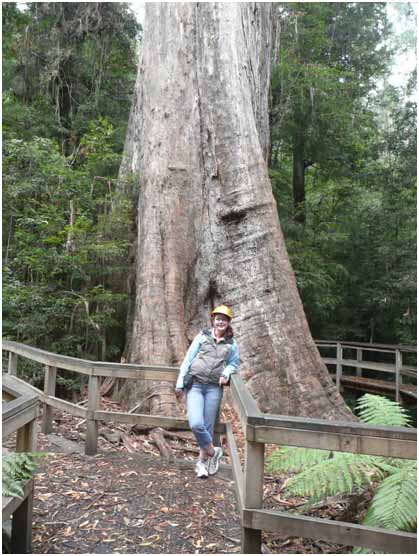
© 2009-2012 CRC for National Plant Biosecurity | Disclaimer
![]()


Kylie Ireland, PHD student was reinvigorated to reach her research goals and contribute great scientific work to the plant biosecurity community after she attended the IUFRO Forest Biosecurity Conference and had the opportunity to meet with her supervisor, Dr Ian Smith.
In March 2009 I attended the International Union of Forest Research Organization (IUFRO) International Forest Biosecurity Conference in Rotorua, New Zealand. The conference was a fabulous mix of scientific disciplines, integrated with policy and management perspectives, and was an overall success for all who attended. Presentations at the meeting covered pest risk analysis (in which I presented my work), quarantine, pathology, pest and vegetation management, surveillance and detection and diagnosis. The conference also included a full day workshop titled ‘Managing the biosecurity threat to forests in a changing global environment: links between science, policy, regulation and management' supported by the Organisation for Economic Cooperation and Development which was particularly engaging. The importance of communication between scientists and policy makers was a particularly salient and recurring theme of discussions.
I then attended the field trip which was most engaging, covering native to plantation forests and chemical treatments at the port. There was also plenty of opportunity for sightseeing along the way. We were treated to the beauty of New Zealand's natural forest which is protected from invasive organisms such as the ringtail possum. We also explored plantations of pine dealing with weed problems (where we deployed the Buddleia leaf weevil as a biological control), and the decimation of Eucalyptus gunnii plantations by the Septoria leaf blight pathogen, Kirramyces eucalypti. Seeing the methyl bromide demonstration at the Port of Tauranga was a great treat. Rarely does one get to see inside an operational port, and it was exciting to see the technology being employed to allow trade in forestry to continue more effectively and efficiently while ensuring biosecurity was not compromised.
Post-conference I visited my supervisor, Dr Ian Smith in Melbourne to tour some of the areas of interest in case of a Phytophthora ramorum incursion. Seeing the forest blanketed in fog the importance of my work really hit home with a number of my test species in close contact with one another. The conference and visit to Melbourne really helped me put my work into perspective and it gave me the opportunity to network, share my research, and build collaborative links. I am now inspired to complete the home stretch of my thesis work.
I would like to thank the CRCNPB for the travel grant to attend the conference and visit my supervisor in Melbourne. It has reinvigorated my research goals and my resolve to contribute great scientific work to the plant biosecurity community.

Kylie Ireland by one of the oldest Eucalyptus regnans in Australia.
Links:
[1] http://legacy.crcplantbiosecurity.com.au/project/crc10001-early-warning-threat-identification
[2] http://legacy.crcplantbiosecurity.com.au/users/irelandk